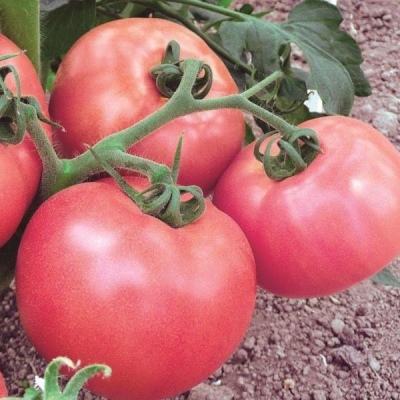
- Category: hybrid
- Appointment: fresh consumption
- Ripening period: mid-season
- Ripening time, days: 115
- Growing conditions: for film greenhouses
- Bush height, cm: 150-200
- Bush characteristic: powerful
- Leaves: large, dark
- Ripe fruit color: hot pink
- Fruit shape: smooth
Many gardeners prefer tall tomatoes because they believe they are more productive. Among the popular hybrids is Rosemary, the fruits of which are suitable only for fresh consumption.
Description of the variety
This hybrid is suitable for film greenhouses. The bushes can grow up to 2 meters in height, while they grow vigorous, with large dark green foliage.
The main qualities of the fruit
Ripe tomatoes Rosemary of bright pink color. They are quite large, the maximum weight is up to 400 grams.
The pulp inside, although dense, is quite juicy and tender.
Taste characteristics
The fruit of the Rosemary hybrid has a pronounced tomato flavor.
Ripening and fruiting
The ripening period of the described variety is 115 days.
Yield
The yield per bush is 8-11 kg.
The timing of planting seedlings and planting in the ground
March-April is the time for planting seeds, young tomatoes are transferred to the ground when the seedlings are from 55 to 70 days.

Growing tomato seedlings is an extremely important process, because it largely depends on whether the gardener will be able to harvest at all. All aspects must be taken into account, from seedbed preparation to planting in the ground.
Landing scheme
In this case, a scheme of 2.8-3.0 plants per square meter is used. m.

Growing and care
In greenhouses, it is recommended to water Rosemary with rainwater, because nutrients dissolve better in it, and it is easier for plants to get them from the soil. Tap water is hard, and even more so well ice water is not suitable for tomatoes.
Watering rosemary tomatoes is necessary in the morning or evening, when there is no heat. It is impossible during the day: a large difference in air and water temperatures can cause physiological shock in plants. With such watering, tomatoes of this variety can wilt.
Watering is carried out only at the root, since when water gets on the leaves, the risk of developing phytophthora increases. As for the frequency of watering, there are no clear recommendations, since it all depends on the climatic conditions and the composition of the soil. During the ripening period of the fruit, it is better to water Rosemary not too abundantly, but often, trying not to allow the soil to dry out. Keep in mind, however, that too much moisture can lead to root rot.
Mulching the beds is very important, since this technological method allows you to retain moisture, stabilize the temperature of the soil: it heats up and cools slowly, does not overheat. Under a layer of mulch, the soil becomes loose and airy, earthworms are actively working in it, and beneficial soil microorganisms multiply.
To care for rosemary tomatoes in August, you need to feed with potassium.It participates in the metabolism of the plant, has a positive effect on immunity, accelerates the ripening of tomatoes, increases the number of ovaries, and improves the taste of fruits.
Top dressing can be done at the rate of one matchbox of ammonium nitrate and potassium sulfate per 10 liters of water. At the same time, at least 3 liters of such a solution must be consumed per bush. You can also feed the tomatoes Rosemary and ash at the rate of 1 cup per 10 liters of water.
Curling of leaves into tubules can be observed on Rosemary at high air temperatures. At the same time, at night, they return to normal. There are several ways to solve this problem:
- use mulching of the beds;
- use covering materials to shade the culture from the scorching sun;
- carry out preventive spraying of plants after sunset with solutions based on manganese or urea.
Rosemary leaves also curl due to excess nitrogen fertilizers. An overdose of nitrogen can be determined by the appearance of tomato bushes:
- very thick stem;
- foliage is watery and brittle;
- leaves curl into a ring.
The problem is solved after the abolition of nitrogen fertilizers. You can maintain the vitality of Rosemary with the help of complex dressings.




A plant needs different micronutrients at each stage of growth. All fertilizers can be divided into two groups: mineral and organic. Folk remedies are often used: iodine, yeast, bird droppings, eggshells.
It is important to observe the rate and period of feeding. This also applies to folk remedies and organic fertilizers.
Disease and pest resistance
Tomato Rosemary cracks in dry air and insufficient watering.



























































































